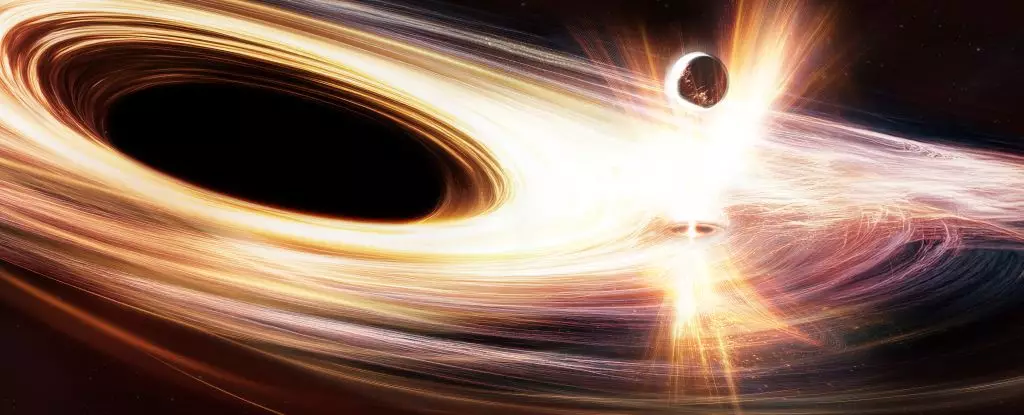In the vast expanse of the universe, celestial phenomena continue to capture the fascination of both scientists and enthusiasts alike. Among these, supermassive black holes stand out, not just for their gravitational might, but for their peculiar behaviors and the secrets they harbor. One such enigma is the supermassive black hole identified as Ansky, located 300 million light-years away in the galaxy SDSS1335+0728. Since its unexpected awakening in 2019, Ansky has become a focal point in astrophysics, challenging our understanding of black hole dynamics and their evolutionary pathways.
The Unfolding Drama of Ansky’s Eruptions
Astrophysicists have been monitoring Ansky with keen interest as it transitions from a state of quiescence to one of explosive activity. The recent series of energetic explosions observed from Ansky—dubbed quasi-periodic eruptions—have left researchers astounded. Joheen Chakraborty from MIT points out that these eruptions are not only longer than previously recorded but also exceedingly luminous, releasing energy levels that dwarf typical black hole emissions.
The sheer intensity and duration of Ansky’s eruptions—lasting approximately 4.5 days—defy established models. Such characteristics challenge the conventional comprehension of how material interacts with the environment around a supermassive black hole. This raises fundamental questions: What is driving these anomalies? Why does Ansky exhibit such unprecedented behavior? These are inquiries that could shift paradigms in black hole studies.
Redefining Conventional Wisdom
Common knowledge paints black holes as insatiable cosmic vacuum cleaners, but this is an oversimplified view. The reality is far more complex. Supermassive black holes, including the one at the center of our own Milky Way, oscillate between active and dormant states. During periods of activity, they consume surrounding matter, emitting energy that can illuminate galaxies. Ansky’s current behavior disrupts the simplistic narrative of black hole behavior, forcing us to reconsider what we know about these massive entities in the cosmos.
The process of a black hole transitioning from quiescence to activity is crucial to understanding how they and their host galaxies evolve. For instance, the activity rate of black holes correlates to the formation of stars within galaxies, thereby influencing the chemical makeup of the universe.
The Groundbreaking Observations of 2019
The discovery of Ansky’s first quasi-periodic eruption in 2019 marked a watershed moment in black hole research. Unlike any previous observations, this event provided a tangible glimpse into the awakening of a supermassive black hole. According to astronomer Lorena Hernández-García, this was the first occasion in which researchers could witness a black hole “waking up” in real-time, thereby offering invaluable insights into the specifics of these mysterious eruptions.
As astronomers analyze the light emitted from Ansky, they encounter a remarkable range of wavelengths—from infrared through to X-rays. The vibrant emissions raised critical questions about what could be causing such brightness across multiple spectrums. Could it be that other theories, which postulate that the eruptions stem from smaller celestial bodies getting ensnared and spiraled into a black hole, are too reductive? Ansky appears to suggest more complex mechanics at play that defy current understanding.
The Intersection of Black Holes and Gravitational Waves
The excitement surrounding Ansky extends beyond simply observing extraordinary light emissions. Edwin Quintin of the European Space Agency hints at a deeper intrigue: the potential connection between these explosive bursts and gravitational waves. This burgeoning field of study promises to expand our understanding of both black holes and the fabric of spacetime itself.
The prospect of future missions, such as the European Space Agency’s LISA, may further elevate our comprehension of black holes like Ansky. An investigation into gravitational waves associated with these unique eruptions might uncover insights that could alter our contemporary physics framework, revealing interconnected phenomena across unimaginable distances.
Charting New Territories in Astrophysics
Ansky serves not only as a window into the strange dynamics of supermassive black holes but also as a catalyst for new research avenues in astrophysics. As scientists grapple with the implications of Ansky’s unprecedented activity, they are compelled to rethink black hole models and the role these entities play in cosmic evolution.
In short, Ansky is more than a black hole; it represents a challenge to the scientific status quo. Its perplexing behaviors unsettle our established understanding and push the boundaries of astrophysical research, making it an exciting focal point for future explorations in the universe’s mysterious tapestry. This supermassive black hole has indeed become a litmus test for our current astrophysical paradigms, and as we gather more data, we stand on the precipice of potentially groundbreaking discoveries that could redefine our grasp of the cosmos.


Leave a Reply